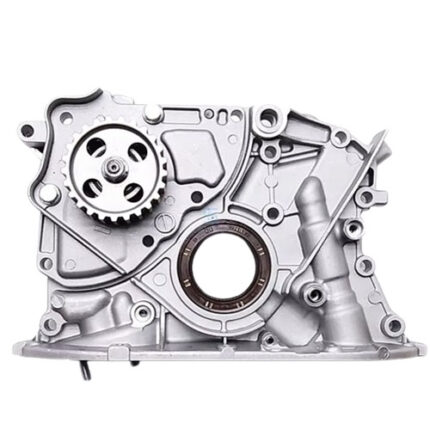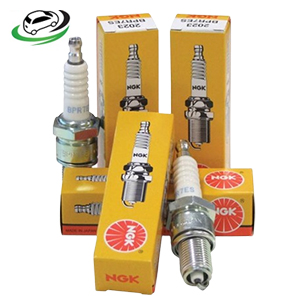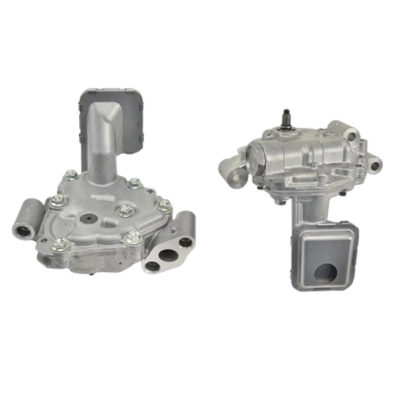-17%
Get Oil Pump Assy For Toyota With 1AZ-FSE Engine in Kenya
The Oil Pump Assembly is a critical internal engine component that plays a central role in maintaining lubrication and cooling within the engine. It ensures that all moving parts receive a steady and pressurized flow of engine oil, which reduces friction, minimizes wear, and helps regulate engine temperature. Without a properly functioning oil pump, an engine cannot survive for long—making this component one of the most vital for engine performance and longevity.
The Oil Pump Assembly is engineered to operate under high loads and extreme temperatures, constantly circulating oil from the sump to vital areas such as the crankshaft, camshaft, pistons, valves, and timing components. Its consistent operation ensures that the engine runs smoothly, quietly, and efficiently.
Purpose and Function
The primary role of the Oil Pump Assy is to draw oil from the oil pan (sump) and distribute it under pressure throughout the engine’s lubrication system. This pressure ensures the oil reaches even the most remote engine components and keeps them operating without direct metal-to-metal contact.
Core Functions Include:
-
Oil Circulation:
Pumps oil through internal galleries to lubricate bearings, gears, and chains. -
Pressure Regulation:
Maintains optimal oil pressure to ensure proper flow at various engine speeds. -
Cooling Assistance:
Facilitates heat transfer from engine components to the oil, aiding in temperature regulation. -
Debris Transport:
Helps move carbon, metal particles, and other contaminants to the oil filter for removal.
Without a functioning oil pump, engine parts would quickly overheat, seize, or become irreparably damaged due to lack of lubrication.
Construction and Components
The Oil Pump Assembly is a compact, high-precision unit typically mounted near the crankshaft or inside the timing cover, depending on engine layout. It is powered directly by the crankshaft or camshaft through gears or chains.
Common Components Include:
-
Pump Housing:
Typically made of cast aluminum or high-grade steel, the housing contains and supports the pump’s internal components while withstanding extreme pressures and temperatures. -
Rotors or Gears:
The pumping mechanism may use a rotor (in a gerotor or trochoid-style pump) or meshing gears (in gear-type pumps) to move oil efficiently. -
Relief Valve:
Built-in pressure relief or bypass valve prevents excessive oil pressure that could damage seals or filters. -
Drive Shaft or Gear:
Connects to the crankshaft or camshaft to rotate the pump mechanism. -
Pickup Tube and Screen (optional in assembly):
Draws oil from the sump while filtering out large debris before it enters the pump. -
Mounting Flange and Bolt Points:
Precision-machined surfaces ensure proper sealing and alignment during installation.
Each of these components is carefully designed and machined to tight tolerances to ensure consistent oil delivery under all engine conditions.
Types of Oil Pumps
Several designs are used across different engines. The most common include:
-
Gear Pump:
Uses two meshing gears to create flow and pressure. Reliable and simple. -
Rotor Pump (Gerotor or Trochoid):
Consists of an inner and outer rotor with offset lobes, offering compactness and efficiency. -
Variable Displacement Pump:
Adjusts oil pressure and flow depending on engine demand, improving efficiency and fuel economy. -
Dry Sump Oil Pump (for performance engines):
Multi-stage pump used in high-performance or racing applications, with separate oil reservoirs.
Each design is selected based on engine configuration, performance requirements, and packaging constraints.
Performance Characteristics
A high-quality Oil Pump Assy contributes to engine performance and reliability by providing:
-
Consistent Oil Pressure:
Maintains a steady supply of oil at both idle and high engine speeds. -
Rapid Priming and Circulation:
Quickly delivers oil during cold starts, reducing engine wear. -
Durability Under Load:
Withstands long operating hours and extreme thermal cycling. -
Efficiency:
Delivers only the necessary volume and pressure, reducing parasitic losses. -
Quiet Operation:
Precision balancing and tight clearances help minimize operating noise.
These characteristics are especially important in modern engines with tight tolerances and advanced valvetrain systems.
Symptoms of a Failing Oil Pump
Failure of the Oil Pump Assembly can lead to catastrophic engine damage. Early detection is essential.
Common Signs of Failure:
-
Low Oil Pressure Warning Light:
One of the earliest and most critical warnings. -
Engine Noise:
Increased valvetrain noise (ticking or knocking) due to insufficient lubrication. -
Overheating:
Lack of oil flow results in poor heat dissipation. -
Oil Pressure Gauge Drop:
Gradual or sudden decline in oil pressure readings. -
Poor Engine Performance:
Loss of power, rough running, or stalling under load. -
Oil Foaming or Aeration:
Can indicate internal pump damage or suction leaks.
If any of these symptoms appear, immediate inspection and potential replacement of the oil pump are necessary.
Installation Considerations
Replacing an Oil Pump Assembly is a labor-intensive job that typically requires removal of the oil pan or front engine cover. It should be done by experienced technicians to ensure proper alignment, torque, and priming.
General Installation Process:
-
Drain Engine Oil:
Remove old oil completely to prevent contamination. -
Remove Oil Pan and/or Front Cover:
Depending on pump location, access requires disassembly of related components. -
Inspect Pump Mounting Area:
Clean thoroughly to ensure proper sealing and operation. -
Install New Pump:
Align gears or rotors properly and torque bolts to spec. -
Check Relief Valve and Pickup Tube:
Replace or clean as needed for reliable function. -
Prime the Pump:
Some pumps must be filled with oil before starting to ensure immediate pressure. -
Reassemble and Fill with Oil:
Use recommended oil type and level. Monitor oil pressure during initial startup. -
Test for Leaks and Oil Pressure:
Confirm normal operation before resuming vehicle use.
Maintenance Tips
While the oil pump is generally maintenance-free, certain practices help prolong its service life:
-
Use High-Quality Engine Oil:
Reduces sludge buildup and provides better lubrication. -
Change Oil and Filter on Schedule:
Keeps the oil system clean and free from abrasive particles. -
Avoid Prolonged High RPM Without Proper Warm-Up:
Prevents thermal shock and oil starvation. -
Inspect Oil Pickup and Screens:
Ensure they’re clean and unobstructed during major services. -
Address Oil Leaks or Pressure Drops Promptly:
Avoid running the engine with low oil pressure.
Follow us on Facebook for more parts.



